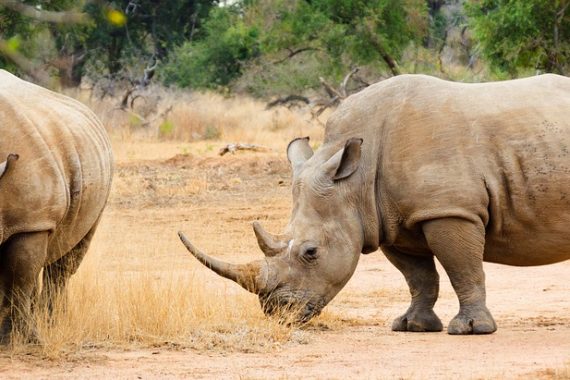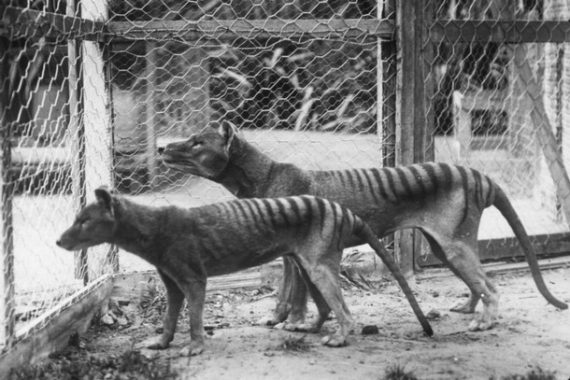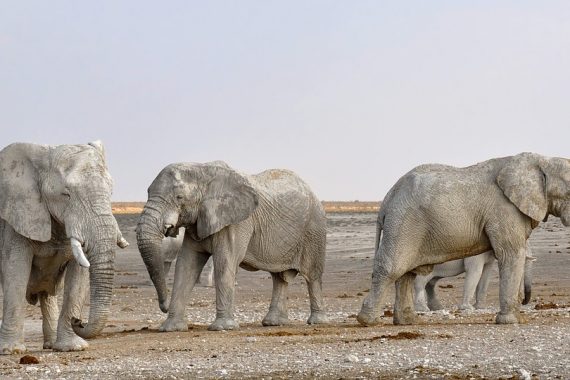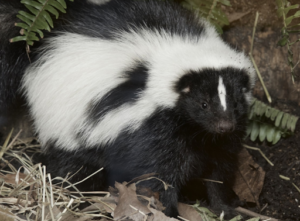
Image from the Smithsonian National Zoo
The Striped Skunk (Mephitis mephitis)
Despite its small size, fluffy appearance and generally docile nature, the sight of s skunk strikes fear into the hearts of many animals. Not for their teeth, claws or ferocity; but for the rather unpleasant, hard to remove mist they can squirt out of their backsides! All skunks, including the striped skunk with its striking white streaks running from head to tail, have glands at the base of their tail that allow them to produce the pungent mist they use to spray over potential predators or any animal that makes them feel threatened (including many unfortunate dogs!). Residing throughout Southern Canada, through the United States and into Northern Mexico, this small-bodied carnivore is a common sight (and smell!) in these areas. For those outside the US, the striped skunk may be more well-known from the Disney movie Bambi, where the titular deer character has a close skunk friend called Flower, or perhaps Pepe Le Pew, an animated skunk from the Warner Brothers Looney Tunes cartoon.
Evolution and Taxonomy: a rather stinky family
All extant skunk species evolved from a primitive genus called the Martinogale, one of the earliest members of the species we see today, discovered from a fossilised skull and lower jaw in California. This common ancestor migrated to the New World in the late Miocene, between twenty-three to five million years ago. As generalist species, these ancestors coped well with the huge climatic fluctuations that occurred during the Pleistocene Epoch, particularly the retreat of a large glacier in the Wisconsin region that allowed populations to expand their range further. This led to two separate lineages of striped skunks today, one in the South and one in the Eastern regions of the US.
Skunks are part of the Mephitidae family of small mammals, which includes the skunks and stink badgers. This was not always the case; at one-point skunks were considered to be part of the Mustelid family which contains badgers, minks and otters to name just a few. But after genetic analysis, the skunks were instead moved into the Mephitidae family, consisting of 12 extant (equally smelly) species in 4 genera:
- Conepatus; the hog nosed skunks.
- Mephitis: the hooded and striped skunks.
- Mydaus: the stink badgers.
- Spilogale: the spotted skunk.
Habitat and Ecology: an iconic North American species
Skunks are common throughout the lower forty eight states and range up into Southern Canada and down into Northern Mexico, although they generally avoid the hottest and coldest areas. As a habitat generalist, striped skunks can be found in a vast diversity of ecosystems, from woods, plains, arid locales and semi-urban areas. Studies have found that skunks are particularly abundant in agricultural areas, perhaps because of the food resources available for them there.
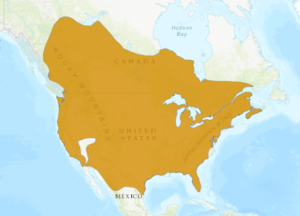
The wide range of the Striped Skunk (image from the IUCN red list)
Despite their powerful deterrent, skunks are fairly calm creatures, solitary and mostly nocturnal. Skunks are well known for their denning behaviour, using hollow logs, trees, rock or brush piles and the undersides of buildings. Although they don’t hibernate in winter, in the colder areas of their range they will take on a very sedentary lifestyle, relying on their fat stores and engaging in what is known as communal denning when several, normally solitary, skunks will inhabit the same den, keeping close together for warmth. It is this behaviour which has unfortunately led to a lot of concerns over disease transmission and the risk this poses to humans from diseases such as rabies and leptospirosis.
Skunks are not fussy when it comes to food, and although they are primarily insectivores, chowing down on insects such as grasshoppers, crickets, beetles and larvae, they will also eat other invertebrates such as crayfish, worms and arthropods and occasionally eat small mammals such as voles.
Causing a stink: Skunk secretions
All skunks have enlarged anal glands at their base of their tails which produces the pungent, yellowish musk the species is famous for. This can be sprayed as far as six metres when the skunk is frightened or surprised. At a high enough concentration, the spray can cause nausea, retching, pain and causes eyes to water fiercely, even temporary blindness if the spray comes into direct contact with the eyes. The major components of skunk spray are chemicals called thiols, which account for the sulphurous stink people that have been unfortunate enough to have been sprayed have described. Skunks are predated upon by a few animals, such as the Greater Horned Owl and Coyotes, but only 5% of skunk mortality is actually attributed to predators, showing just how effective their stinky butts are at keeping them safe!
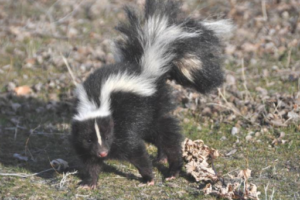
Watch out! A skunk in a defensive posture, ready to spray: back arched, tail lifted
Despite popular misconceptions, skunks don’t just wander about spraying willy-nilly at anything that crosses their path. They will only spray if they feel really threatened or if you catch one by surprise, and they give plenty of behavioural cues as a warning. Its very common for inquisitive dogs to get a face full, and as Angie can attest to; it’s a horrendous stink and it IS NOT neutralised with a tomato juice bath! If you see a skunk stomp its feet, arch their back and lift their tail, it would be a very good idea to scarper!
Ecosystem roles: farmers little helper?
Fortunately, striped skunks are doing pretty well in the wild, being listed as least concern on the IUCN red list. In fact their numbers appear to be increasing, a trend that has been explained by the unfortunate removal of many top predators and other competitive species from the wild. Sadly, this imbalance in the ecosystem has led to skunks causing some issues for humans and other wildlife alike. As generalist feeders, skunks are known to eat bird eggs, and with many ground nesting birds facing serious declines in their numbers, the increasing number of skunks has led to increasing predation rates on bird eggs, pushing these at-risk species closer to extinction. For humans and other wildlife, increasing skunk numbers poses a risk of increased disease transmission, particularly the devastating virus rabies.
However, there are some measures that have been proposed to keep these risks low that helps wildlife, people and keeps the skunks from being lethally controlled, an outcome we should always try and avoid. A study in endangered waterfowl habitat tested the effects of the removal or blockage of skunk denning areas in abandoned buildings. The researchers found this helped to reduce the level of skunk predation on endangered waterfowl nests without the need for lethal control and would likely have positive effects on the reduction of disease transmission, given that considerable transmission occurs in communal dens. Even simple measures like keeping properties clear of trash and leftover food can be a really simple way to reduce conflict, not just for skunks but for other animals like racoons and bears too.
Given this, it’s all too easy to view this common species as nothing more than a rather stinky pest, but this would be ignoring the hugely positive impacts they can have on their environment. For farmers and gardeners, skunks play a big role in keeping the numbers of agricultural pests down, preventing infestations and imbalanced populations, as insects and their larvae make up a large part of their diet. Alongside other common omnivores like racoons, skunks act as industrious little gardeners (minus a trowel and rake) by spreading seeds in their poo across long distances as they forage. Less frequently they have been known to feed on carcasses, acting as part of natures clean up crew. So don’t write off this iconic, cute little critter as nothing more than a pongy pest but recognise and appreciate them as an integral part of their ecosystems.
References:
Barton, H.D. and Wisely, S.M. (2012) ‘Phylogeography of striped skunks (Mephitis mephitis) in North America: Pleistocene dispersal and contemporary population structure.’ Journal of Mammalogy, 93(1), pp 38-51
Houseknecht, C. (1969) ‘Denning habits of the striped skunk and the exposure potential for disease.’ Bulletin of the Wildlife Disease Association, 5(3), 302-306.
LariviÈre, S. and Messier, F. (2002) ‘Denning ecology of the striped skunk in the Canadian prairies: implications for waterfowl nest predation.’ Journal of Applies Ecology, 35(2), pp 207-213
Wang, X. Whistler, D.P. and Takeuchi, G.T. (2005) ‘A new basal skunk Martinogale (Carnivora, Mephitinae) from late Miocene Dove Spring Formation, California, and origin of the new world mephitines.’ Journal of Vertebrate Paleontology, 17(3), pp 936-949
Wilson, D.E. and Reeder, D.M. ‘Mammal Species of the World: A Taxonomic and Geographic Reference’ (2006), John Hopkins University Press
Wood, W.F. (1990) ‘New components in the defensive secretions of the striped skunk, Mephitis mephitis.’ Journal of Chemical Ecology, 16, pp 2057-2065.
Wood, W.F. (1999) ‘The history of skunk defensive secretion research.’ The Chemical Educator, 4(2), pp 44-50


